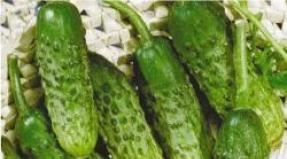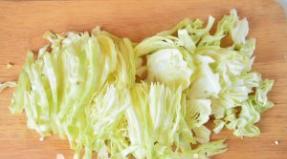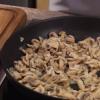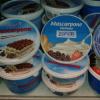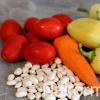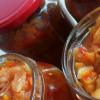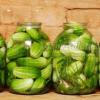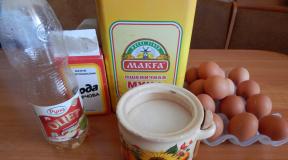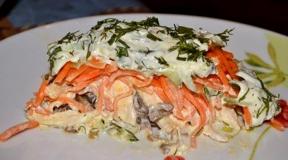Tasty juicy pork meat. What parts do you cut pork for and what of them to cook? How to choose a good pork
Fillets for the second and bones for the soup - these are two types of meat that exist for the majority of today's hostesses: it is now somehow not accepted to go into the anatomical details and the quality of meat resulting from them. And in vain: meat is just that culinary area where the potential of the product decides the fate of the dish.
Any meat dish begins with choosing the right piece. And to make this choice with all thoughtfulness is possible not only in the market. For example, even from the most precious part of pork - brilliant red tenderloin - never cook broth, and not because the tenderloin is bad, but because it is intended for another. In the same way, knowing that parts of the pork gammon are excellent, if you bake them in the oven in a large piece, and the pork shoulder meat likes detailed grinding and roasting or stewing, you will never be disappointed with the result of your culinary work. Of course, this is only true if the meat is fresh. Freshness must also be correct: the carcass must go through a stage of maturation (2-3 days) before turning into mouth-watering, conveniently cut and packed pieces, from which you choose the one that best suits your gastronomic plans.
Useful properties of pork
The cuts below are usually found in the United States. Internationally, your mileage may vary depending on exact cuts and names. Let's start with the top and front of the pig. Pork shoulder or pork pork shoulder is usually sold in grocery stores and butcher shops in the form of a large piece of meat, usually 5 to 10 pounds of weight. Sometimes pork chops are sold with bones, but they are a little less.
The shoulders can be roasted in the oven or stewed, but, of course, my favorite way of cooking barbecues is to slowly simmer them. I like to use apple, hickory, peach or pecan for smoke. Once done, unwind the shoulder and serve on sandwiches, soft cakes or nacho.

1. side part of the ship
of all parts of the ham, this one is the fattest. but oily, not in a negative sense, but in the most tender: a piece of pink meat, like a gossamer, is woven over by a thin net of fat, which during cooking gives the pulp juiciness and enhances its flavor. the side part can be seen on the counter under the name “pork”: technologically, this name is not quite right, but culinary more than justified - it is from this part that the most successful pork comes out, and in general it is perfectly suitable for baking.
“Picnic Ham” Immediately after the shoulder - the next neckline, which you will most likely find: “Picnic Ham”. They can be smoked or extinguished. The huge thick picnic cap is awesome for cracking. Pork Steaks If you are in the St. Louis metro area, you probably know about the delicacy that is wonderfully grilled pork steak.
Front Hawk Usually sold as a “ham” in a store, and, as a rule, it is already salted and smoked. Pork spoon Looking back, we find the lower back. Very thin and tender, pork tenderloin is an excellent piece of meat and comes from the back of a pig. Pork chops Thick or thin, bone or boneless pork chops are cut from the meat perpendicular to the spine, often from the loins.
2. TOP OF THE KOROK
the top of the ham is considered the best. in fact, the whole ham is evenly good, and its parts differ only by the volume of the fat layer. Historically, the ham was sold and prepared entirely and no internal, external, lateral and upper parts differed. today, such a cutting is not a consequence of culinary differences of parts, but a matter of elementary convenience. The main purpose of this part of the gammon is to inspire the housewives to make fragrant thick goulash.
It can be grilled, smoked or baked. Bacon is a pig belly that is cured, smokes and is cut. The ribs of the baby back When you de-bone the pork loin, the ribs that come off of this are the back ribs of the baby. They are a more tender option for the ribs: The meat between the ribs is lumbar meat, not belly meat.
Spare ribs Spare ribs are detached from the abdomen. Spare ribs are available both in the regular style and in spare ribs in the style of St. Louis, the later of which had removed the bones of the sternum, cartilage and ribs. The shape of Louis is almost rectangular. Siloin. Yes, even pigs have sirloin. This odd, irregularly shaped pork pork is often cut into chops, and they are more meaty and have more flavor.
3. internal and external parts of the OKOKOROK
both of these portions of pork ham are sometimes called simply “top grade pork.” it is right - to hell with the details when you have such beautiful meat in your hands. In the conditions of urban cuisine, the optimal scenario is to bake an impressive piece in the oven or make fragrant juicy chops. can be turned into a fine straw in the Chinese style, followed by rapid frying. let alone grill and barbecue is better not to find pork.
Back leg Most people eat their back leg like a ham, smoke it and process it in some way. Hawk The back fist is similar to the shank of the front foot. He usually heals and smokes. Half or whole pig. Believe it or not, many cultures and cuisines use pig heads.
Ears are eaten more than internationally than in the states; ears can be cooked, grilled, fried or marinated. Pig Noses Legs are often used in soups. The main product for the soul, pig jaws are cured and smoked. Tail can be grilled or baked in the oven. Although the tail is a little more cartilage and less meat, the tails can be similar to eating pork ribs.
4. Brisket
the beauty of the brisket is in tangible layers of fat, telling the meat some simplicity and coziness, and the cook has the freedom to handle it. The only thing that does not harmonize well with the nature of brisket is baking as a whole piece. therefore, first and foremost, turn brisket into more or less large chunks. and then - do what you want: simmer in pots with vegetables, cook pilaf, roll up rolls, simmer with cabbage in the German manner or with potatoes - in Russian. Bacon, by the way, is also prepared from this part of the carcass.
Not good for many, except adding flavor to the stock, as trotters are practically all cartilage. Pork Cuts - Learn about pig parts. Attached to the rear ribs and tenderloin. Once they are removed, the remaining muscle is divided into three parts. Rib or blade closest to shoulder; center slice; the end of the filet, closest to the foot.
Usually it is sold whole or cut into three: inside, outside and tip. Ham is skinny, so it's best to cook with dry heat, for example, fry or fry. Pigs bred for the supermarket provide lean, stable meat and fat. So rare breeds are gaining interest from butchers and cooks. The two hereditary rocks that attract the most attention to their excellent taste are Berkshire and Tamworth. Watch it in many forms, including cured or smoked, such as bacon and prosciutto.
5. back shank
chubby called the lower part of the pork leg, almost completely devoid of meat, but consisting of wonderful bones and cartilage, rich in gelatin. The latter circumstance makes the shank no longer a consumable, but a very valuable material - for the preparation of broths and aspic. the shank served in this way is usually thrown away, however, there are lovers of nibbling pork cartilage, which bread the boiled shank in bread crumbs, fried and consumed with different sauces.
Try it in a restaurant or ask your butcher for availability. Primarily pork bacon, they make the revival as an excellent dual-use pig for their tasty meat and huge bacon. Spiced pork Some supermarkets sell what is labeled “spiced” pork, that is, it was introduced in brine containing salt and sodium phosphate. Since some cuts are quite scanty, they may seem too dry and hard when preparing. Pollinated pork retains moisture, even when overcooked, but less fragrant than as a result of irregular regular pork.
6. shovel
Amateur cooks have become accustomed to thinking that the question of stiffness is relevant only for beef. however, if you choose the wrong part of the pork, chewing muscles will not be easier. For example, the upper part of the front leg, called the spatula, can unpleasantly surprise with its rigidity if it is fried (especially with a large piece). That is why it is better to simmer or cook the spatula, and a little longer than other parts of pork. It can also be minced, but be prepared for its ascetic fasting.
Pork for cooking: think about pink. The touch of pink in pork is safe and desirable, especially in order to maintain light and juicy cuts. Concern about undercooked pork is caused by trichinosis, a disease caused by a parasite. However, this is not a health issue for many years.
Pork neck, also called a comb, is either grilled, or grilled with a bone, or knocked down in one piece. It tastes delicious when cooked like a roll. But you can just simmer it or use it as goulash. If it is sliced bone, it will become a throat cutlet.
7. rebra
Although the classic version of beef broth is considered to be beef, pork broth can also be an excellent basis for borscht or soup. to make it work, you need to cook it from the ribs. they willingly give their flavor to the water, and the meat located on them becomes the quality meat component of the first dish. In addition, the ribs are good in all those dishes where you need not so much meat as meat spirit, - in stewed cabbage, potatoes. If you get the strength to chop the ribs - boldly cook pilaf with them.
When the bones are released, you get neck steaks. The knuckle, which is again subdivided into the front and back, lies above the paw, which is also called the pointed leg. In total, one of them calls these different parts Haksen. The meat is dark and strong in taste, but it has a lot of bone and passes through many tendons. Eisbane is fresh or cured to buy. You can cook well in general, but also fry or barbecue. Launched it gives delicious goulash.
The shoulder is the area above the front legs, which merges with the body. Usually you get them already worked, parried and smashed into pieces: a flat shoulder, called the wrong part of the fillet and a thick shoulder part. All shoulder parts take a relatively long time to cook. They are ideal for extinguishing everything, but can also be cut into goulash or stews. From the flat part of the shoulder you can, when it starts, fry. The neck consists of a flat part of the shoulder with a bone — the shoulder blade and the skin.
8. steering wheel
If beer were able to speak, it would say: “where the knuckle is, I am there”. It is not by chance that traditional dishes of the main beer powers of the world, the Czech Republic and Germany, are made from this meaty part of the pork leg. It can be stewed in beer, baked with herbs and garlic, cooked to absolute tenderness and touched with horseradish (and beer, of course), or can be chopped into pieces and stewed or cooked strong broth. however, you can hardly use the last two sentences: the first three are too seductive.
For the latter, they need to be cured and smoked. The thick rib lies on the lower side of the shoulder on the ventral side and has coarse-grained, mixed meat that is relatively fat. You can use them very universally: boil, stew, roast or grill. It can be used with or without bones. Once a fat rib is cured and smoked, it provides a tasty base for succulent stews.
The swine belly has a very fat reputation. He releases it or together with the rib bones. Depending on the treatment, you can buy pork belly in the form of striped bacon, bacon or breakfast. Spareribes or flaking ribs, which are so popular for barbecues, are ribs “cleaned” from the belly of a pig.
9. back
she is a brisket - which means that it is precisely that part of the pork carcass that for many chefs and gourmets is the only significant one. Indeed, it is the best, most tender pork meat, almost lean, but surrounded by a small layer of subcutaneous fat, which can be cut and left, depending on preferences. As a rule, this part is divided into entrecote (meat on the ribs) and the cutlet part - elongated fillet, oval in section. both parts are perfect for frying, roasting, as well as kebabs.
Reverse fat is also called green bacon. It gives it fresh or smoked. As the name suggests, it comes from the back of a pig. It is used for collecting large hot and for barding. Ham - the upper part of the hind legs of the pig. In the kitchen, it is suitable for frying and stewing. Refined with various recipes, it can be processed whole with a bone into a large tasty ham. But it can also be plastered and divided into different parts, such as the upper and lower shell, walnut, bacon or thigh. In addition, ham can be produced from these various specialties.
10. NECK
according to many amateurs and professionals in the field of kebabs, it is from the neck that it turns out to be the most successful - not too fat, but by no means dry. Indeed, the juicy and tender meat of the neck, with thin fatty veins, can make a kebab truly grandiose gastronomic experience. This meat is also suitable for thin slices for the purpose of short frying, and for prolonged stewing, and for preparing outstanding chops of chops.
For example, cooked and raw ham is produced from the upper and lower shells. These lighter, lighter parts are preferred for raw ham, darker for boiled ham. But they get fried and stewed meat. The upper shell lies inside the club. Their meat is considered to be of very high quality and largely scarce. In general, it is perfect as roast. Cut across the fiber, this leads to a fine schnitzel or can be used as chopped meat. Also suitable as goulash, great.
The bottom shell is outside the club. It is offered to the butcher with fat and skinned without fat. Diamond cut and well seasoned, you can cook a delicious crusty heat from the bottom of the sink. By the way, it is commercially available as a crispy ham. If the bacon and rind are removed cleanly, the schnitzel can also be cut from the bottom shell. You can also cook goulash or roulade roaster.

1. Cutting
the most valuable source of pure meat, completely without streaks and other unpleasant nuances. Like all the best in life, tenderloin is limited in quantity: in one carcass it is usually not more than 1.5-2 kg. That is why it is expensive, but deservedly so: the loose structure of the fibers makes cutting the best part of the carcass for portion roasting. medallions, steaks, kebabs - all this will get to your plate in the best possible way: the tenderloin is not deformed during frying, but becomes soft and allows fragrant juice.
The nut, sometimes called a mouse, has a very thin fiber, lean meat, from which you can make thin roast. From it nuts are made by pickling and smoking meat. In addition, bacon or thigh - very small cuts of meat. You can fry and simmer with the peel, cook goulash or peel from the fondue without the peel.
Pork is divided into two main groups
The fillet is quite expensive, since there are only two figures on the animal. Fillets are small, delicate muscles that lie on the inside of the lumbar ribs on either side of the spine. You can fry the fillet as a whole, but also cut the medallions and fry for a while.
2. shank
This part of beef carcass can also be found under the name "knuckle" or "buldijka", but the essence of the matter will not change: this is the part of the leg, in which there are enough tendons and meat. It is from this that the most fragrant, thick, due to the high content of gelatin, is obtained, the broth, if you cook the shank together with the brain bone, and the excellent stew, if you remove the bone in advance. but the classic use of the posterior shank, of course, is jellies, cold beet, hashi.
Chop is cut from the so-called chips. It is located on both sides of the spine between the neck and the back. The core and ribs are beaten from the front, and the loins, fillets or lobsters are beaten from the back. The criminal skull is slightly larger than the chop. Both varieties can be cooked with or without bone. The most suitable are chops, breaded or non-steamed, for frying or grilling. Cured and smoked, they are known as Kassler chops. If it is triggered, the shredded thread can also lead to a delicious roll.
The dressing, also known as pork brisket or chop, comes from trimmed fillets or chops. Their meat is tender and very thin. From it steaks can be cut into a short roast. In general, it can be, if not too high, fried or stewed.
3. Brisket
without beef brisket, do not boil any good, rich broth, no borscht, or pea soup. or rather, it is possible to cook, but all of this will be deprived of the balance of meat, fat and bones, which gives fragrantness to any first dish. brisket meat, separated from the bone, moderately sandwiched with fat, suitable for salting. You can chop the brisket into pieces and boil or extinguish. in general, everything that is connected with a large amount of liquid will go to brisket for good. but for frying it is decidedly unsuitable.
Pork heart fried, stewed, cooked or cooked on the grill. It weighs from 200 to 300 grams and consists mainly of solid muscle meat. The liver should only be lightly fried so that it does not become heavy. It consists of very tender meat; The same applies to the kidneys. They can be sliced, stewed or fried.
Also try the following delicious pork recipes
On the other hand, it is easier to leave your fingers in the supermarket. They are not always fresh, usually too thin and dry quickly. For those who love juicy pork steaks, chops or love, here are tips and recipes.
Marble or grease
For grilling, they are especially pieces of meat that are beautifully decorated with marble, so that they intersect with fat or have a greasy edge. These slices remain particularly succulent in short, hot cooking methods. These include cuts to the neck, back and hip, especially steaks, chops and well-trimmed loins.4. DANGER
the rule applies to beef neck: the farther to the body, the softer and more digestible. so, the notch is the front of the neck, located closer to the head. However, this does not mean at all that slicing is not good for anything - it is from it that the excellent juicy stuffing is obtained, which can be used for meatballs, meatballs, and for the preparation of the filling. Of course, with equal success it is possible to cook minced meat from a thin edge or, say, tenderloin, but will it be justified?
5. shovel
scapula has two technological incarnations - the pulp and the meat on the bone. fine-fiber pulp to the culinary ideal is one step, namely the removal of a circular layer of fat that is absolutely unnecessary from the point of view of gastronomy. After this simple procedure, the scoop's flesh becomes like a rump or thin edge, but in this case it is better to refrain from frying a large piece: it will be more efficient to cook beef stroganoff, rolls or chops. Use the scapula on the bone to make broths.
6. Crest
This is a relatively large piece of the femoral part of the carcass, boneless and with a moderate fat content, which envelops the knuckle, as it were, and therefore can be easily cut. knuckle is not forbidden to grind pieces of arbitrary size and stew with vegetables or in their own juice, make it chops or rolls. but will the hand rise? a clean, bright red knuckle asks for a whole piece of foil and an oven to turn into classic English roast beef or, in Russian, boiled pork.
7. SLIPPING
in its qualities, it is similar to the shank. yielding the flesh of the scapula in tenderness, the shoulder part gives it a head start in the sense of cooking dishes from boiled beef. finely chop and put out the shoulder part for a long time - also means to get a guaranteed good result. you should only take into account that in the shoulder part there is a lot of bone. roasting is more difficult, but, if very necessary, separate the meat from the bone in a large piece and fry whole, pre-stuffed and constantly pouring out the secreted juice.
8. PACKAGE
there is enough meat in the tomb, slightly dry, but perfectible, and thin, but noticeable fat. in order for both to become one whole, canceled in taste, it is best to prepare the side fenders in one large piece, previously stuffed. moreover, the cooking process can take place both in the oven and in a large saucepan on the stove. If there is no time, just thin the meat and fry in an almost dry skillet. Especially recommended for the cooking of beef stroganoff and langet
9. rebra
in combination with or without brisket, beef ribs are the key to success in a long, but not difficult, case of correct selection of raw materials for cooking meat broth. the ribs broth is light and transparent, but at the same time brewed and tasty, and the cooked meat is separated from the bones in just one motion, in order to get into the soup or borsch in the form of soft, mouth-watering slices in a few more knife strokes. Another option for using ribs is to cut off raw meat from bones and put it into mincemeat.
10. punch
together with the rump, the probe and the undercover, the secatech makes up the upper part of the back leg, a part of the carcass that is distinguished by its particular culinary value. Ssek is clean meat, boneless and cartilage and almost fat free. visually, it resembles a tenderloin, but this similarity is fraught with danger for the chef: unlike a tenderloin, ssek is less juicy and more rigid, and therefore is not suitable for lightning-fast dishes like steak with blood. but for thoughtful frying or stewing, with a preliminary marinating the best piece of beef, do not choose
11. Fat Edge
Although the “thin edge” sounds more proudly than the “thick” one, the gastronomic purpose of both parts of the carcass is approximately the same and rotates around one, almost ritual, procedure — frying. thick fat usually contains more fat than thin, but it is not capable of spoiling the result: if you bake the meat in the dough, or roll a roll out of it, or grill it on the rib, or put it out in a large piece, the fat will give the beef the necessary softness and juiciness. however, thin-fiber meat of a thick edge and so soft enough.
12. tonKiy Land and Kostrets
thin edge - one of the best parts of the carcass: 4-5 lower ribs and lumbar. the meat is juicy, very tender - just the case when you can not worry about undesirable hardness. thin edge and rump are suitable for cooking methods, which, being the most elementary, are considered at the same time and the most noble - roasting and cooking on the grill. meat on ribs, baked in foil or grilled, will be so wonderful that it will require the most worthy wine to accompany you.
13. NECK
the main advantage of the neck of the beef is in its pleasant aroma and fragrant gravy formed by it during the preparation. just not everything can be cooked from this meat: the neck contains a large amount of connective tissue, and therefore is one of the toughest parts of the carcass. however, there are two ways to combat stiffness: firstly, pickling in something aggressive, like vinegar, and secondly, limiting grinding. for example, the filling for the cake will be especially successful from the neck
14. Probe
probe - one of the few parts of the carcass, the meat of which has almost no fat, but due to its fine fiber structure remains soft in almost any method of cooking. prolonged roasting or simmering with herbs is the best thing to do with the probe. However, the outer part of the probe is perfect for making stews, and the inner part is for steak with blood. Finally, it is the dipstick - perhaps the only worthy alternative to tenderloin when choosing a piece of beef on a kebab.
What parts of pork is better to use and for which dishes
After the slaughter of a pig, the butchers cut its carcass into about 40 parts. Each of them is good in its own way, if you know how to cook it. So, for rich broth, it is better to use pork ribs, bones with a small amount of meat on them, scapula or shin. And for cooking jelly more like legs.
The best goulash is obtained from the shoulder, ham, sirloin or loin - the fattest part of the carcass. These pieces of pork can also be used to make cutlets, chops, and minced zraz and roasts. The spatula is generally considered the toughest part of pork, so it must be subjected to a long heat treatment - stewing or boiling.
But it is better to salt the pork ribs, neck, drumstick, knuckle or back loin. Pig tongue and, of course, brisket are also suitable for this purpose. The latter is located on the sides of the abdomen immediately behind the scapula and represents pieces of fat with layers of meat.
Shish kebab is best made from the neck - this part of the pork has fatty layers, thanks to which the meat on the fire turns juicy. For roasting a large piece of ham is best suited - the most meaty part of the carcass, which is a pork buttock. However, today, the ham is usually issued behind the back leg, located just above the knee. From the ham you can make a delicious baked ham or roll.
Steaks, chops, schnitzel and langet also should be prepared from ham, and sauteed medallions and patties from loin. Then these dishes will be especially juicy, soft and tasty. Ordinary meatballs, in principle, can be cooked from almost any meaty part of pork. And for more fat, they should add a little loin.
How to choose a good pork
Pork is good because it is soft. Only a very old animal can have tough meat. However, when buying, there is a danger of getting not a fresh product, but defrosted, which, naturally, impairs the quality of meat. To avoid this, you should choose soft pieces of uniform light pink without bruising. When pressed on the meat, the fossa should quickly recover and return to its natural color, rather than being filled with blood and fluid. The smell of fresh pork is pleasant and not too clear. If the meat smells rotten or emits other unpleasant odors, its purchase should be abandoned.
What is softer, what cooks faster: ham or scapula?
The frozen ham and scapula are prepared in approximately the same way, i.e. there is no particular difference.
If there is, then in the form of a pair, when it comes to visually young meat. Under normal conditions of our market, both parts of meat are suitable for long-term cooking (stewing, home-made ham and rolls). When baking, you can get a harsh and dryish product, so in my family they prefer a neck for baking and frying.
There are a number of culinary tricks that help to brighten up a little dryness, for example, roasting from a spatula or ham. The meat is cut into pieces, add spices and Art. spoon starch, then fried and cooked further on your own. Starch seals meat, preserving juice. By the way, this trick is very good for chicken, namely, breast. Add the sliced breast with soy sauce, pepper, dry garlic and starch, mix thoroughly and just fry. Pieces of the breast are juicy and beautiful (with a gloss of starch).
Meat dishes: which part of pork is better to buy
If you choose pork for the first time, it will be difficult to remember and understand all parts of pork carcass. Experienced butchers cut pork carcass into 40 pieces. For a start, you just need to remember that the most running parts are: shoulder, brisket, brisket and ham.

Scapula - the outer part of the front leg above the knee
The pork shoulder is attributed to premium meat. You can cook boiled and stewed dishes from it, including:
Brisket - dorsal carcass
When cutting cut ribs and meat for minced meat. Brisket is the fattest part of the carcass, so the dishes from it are very juicy.
Breast - abdominal part
Brisket contains fat and is suitable for frying, smoking, grilling. Try to cook from it:
Leg - loin of the back leg
Ham is an excellent meat for frying over an open fire.
Do you know which part of the pork is better to buy on the kebab? You can loin. But the most tender kebab is obtained from the neck. If the meat will be cut when you, take only the side of the neck: from cheeks to the back. See that you do not "slipped" withers - the upper part of the neck.
Often in the winter mistresses cook pork jelly - jelly. It can be boiled from pig's head and legs.
Exquisite table setting at home and delicious dishes from the tongue, ears and heels, will emphasize the attention of the hostess to the guests.
Now you know what part of the pork is better to buy and what can be cooked from it. Pork goes well with melon, dried apricots, prunes, mushrooms. Appetizing pork dishes can be cooked in a slow cooker, oven, on the stove and open fire. Pork is digested no worse than other meat. In addition, its energy value is a big plus for people engaged in physical labor and working on the street. Pork shashlik on New Year's holidays will make your picnic unforgettably tasty.
Enjoy your meal!
Pork is a versatile type of meat that is loved by both adults and children. In the arsenal of each hostess there are many recipes for cooking pork. It is added to salads, cooked soups, aspic, smoked and fried in pans and barbecue. Most people like to eat pork in fried form - very tasty, but not very useful. Therefore, it is best to bake the pork in the oven in special bags, sleeves or foil. Let us figure out how much time you need to bake in the oven a large whole piece of pork and small portions of slices.
Before you start cooking pork in the oven, you should consider the following recommendations:
- In order to make the dish juicy, you should choose the part of the pork carcass on which there is a small fat layer: brisket, shoulder, brisket, ham;
- It is best to buy pork on the market from sellers who sell fresh fresh meat. If this is not possible, buy chilled, but not frozen meat in the supermarket;
- If there is no fat layer on the meat, it should be marinated for at least 3 hours, left in the refrigerator and do not forget to get it from there about an hour before baking;
- Also, the problem of the absence of fatty layers can be solved by garlic and fat, they can be stuffed with a whole piece of meat;
- So that the marinade is not oxidized and does not spoil the taste of meat, you need to cook it in a glass or ceramic dish;
- Not pickled pork is better salted at the end of cooking, as salt can dry the meat;
- Cooking pork is best in thick-walled cast-iron or ceramic dishes, in special bags and baking sleeves, foil;
- During baking in a foil meat is put on the mirror side;
- You can check the readiness of the meat with a knife. If it easily enters and light juice flows out of the formed hole, the meat is ready;
- As a side dish, stewed or fresh vegetables, mushrooms, and any porridge will suit pork baked in the oven. Greens are added to the already prepared dish, since in the oven it may turn black or fade.

How much and at what temperature to cook
Since pork meat can contain bacteria and microorganisms harmful to humans, it must be brought to full readiness. In order not to worry about your health and enjoy delicious meat, the following should be considered during the cooking process:
- whole piece of pork tenderloin weighing about 1.5 kg is baked in foil or bag for 90-120 minutes,
- cooking time stuffed and veiled piece of the same weight - not less than 90 minutes,
- french meat will be ready in 60 minutes,
- unmarked, baked pieces are baked quickly, their cooking time is 30 - 40 minutes,
- on the preparation of portioned rolls in breadcrumbs or batter, you need to add another 20 minutes,
- rolls, meatballs and minced pork cutlets should be in the oven for no more than 45 minutes.

The raw billet is placed in a preheated oven. In order to bake in a foil or sleeve a solid piece weighing from 700 to 1000 g, the oven must be heated to 180 degrees. For roasting pieces, chops or meat in French, the temperature should be no more than 170 degrees. To get crisp, you need to heat the oven to a maximum temperature of 230-250 degrees, and then reduce it to 180 degrees.
Pork in a package for roasting
This dish does not require large financial costs, it is very quick and easy to prepare. In the cold, it will be an excellent substitute for sausages, in the hot - decorate the festive table. Special attention should be paid to the selection of spices. It can be a classic combination of black pepper salt and garlic, or a mixture of seasonings of Armenian or Caucasian cuisine.

Ingredients:
- pork (neck or chop) - 1 kg,
- sunflower oil - 3 tbsp. l.,
- garlic - 3-4 cloves,
- seasoning mix to taste.
In order to cook fragrant pork in a baking bag, the meat must be thoroughly washed, dried and coated on all sides with a mixture of crushed garlic, sunflower oil and seasonings. After the meat is placed in the package, the edges of which are carefully fixed with a special clip. To exit the resulting steam in the package you need to make a few holes with a toothpick or knife tip. The oven must be heated to 200 degrees. Bake pork in the sleeve for 75 minutes.
Pork with potatoes in a marinade of lemon and soy sauce
The main advantage of this dish, the simultaneous preparation of the main dish and side dish. Potatoes can be replaced with any seasonal vegetables: zucchini, zucchini, eggplants, sweet peppers or pumpkin.

Ingredients:
- pork - 500 g,
- potatoes - 500 g,
- parsley - 100 g,
- onions - 1 pc.,
- lemon - 0.5 pcs.,
- garlic - 2 cloves,
- ground pepper to taste
- soy sauce - 1 tbsp.
Before starting to roast, the washed and wiped meat is cut into small portions, salted, peppered and placed in a deep enamel or glass dish. Chopped parsley, onion, garlic, lemon juice and soy sauce are added to the meat. All is thoroughly mixed and left in a cold place. Pickling time - 120 minutes. While the meat is pickled, the potatoes need to be peeled and cut into cubes or circles, mixed with salt and pepper, put in a bag for baking.
Pork is laid on potatoes, so that the meat remains on top during cooking. The package is placed in a preheated 200 degree oven. Bake the pork in the oven with potato slices should be 70 minutes. For a ruddy crust 15 minutes before the package is ready, you need to cut and open the meat.
Also, when cooking pork in the oven, you should pay attention to the pouring and marinade. Experienced chefs advise dry white wine, or lemon juice diluted with wine vinegar. Red wine does not go to the pork, it marinates beef or lamb.

